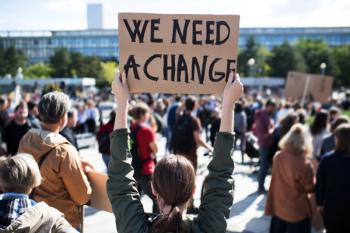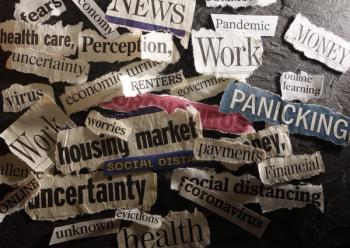
Breaking the Spell: Fighting Myths About COVID-19 Vaccination
The vaccine needs to be appropriately framed: as a benefit, not a risk.
CLINICAL
To help in the prevention of the coronavirus disease 2019 (COVID-19), the Food and Drug Administration (FDA) issued an emergency use authorization (EUA) for the Pfizer-BioNTech vaccine on December 11, 2020. One week later, the same action was issued for the Moderna vaccine (Table 1).1,2 The availability of
A large survey by the Pew Research Center found the intent to get the COVID-19 vaccine dropped from 72% in May 2020 to 51% by September 2020.4 Of those respondents, 77% reported a concern that vaccine swould be prematurely approved without long-term safety data. Among the individuals who did not want the vaccine, 76% expressed concern about its potential adverse effects, whereas 72% wanted to know more about its efficacy before administration. Of the individuals who intended to get the vaccination, 19% expressed a great deal of confidence about safety and efficacy, 45% reported a fair amount of confidence, and 35% reported not much or no confidence at all (Figure 1).4 The intent to get vaccinated increased in December 2020, as 60% of Americans said that they would “definitely” and “probably” get COVID-19 vaccination once it is possible.5
More recently, the Kaiser Family Foundation (KFF) surveyed 1676 adults in the United States from November 30 to December 8, 2020. They found that 71% of respondents reported they would “definitely” or “probably” get the COVID-19 vaccine, whereas 27% expressed concern and were hesitant to receive it.6 The sample was randomized to represent the population, including Hispanic and non-Hispanic Black adults. Vaccine hesitancy was high in individuals identifying as Republicans (42%), rural residents (35%), and Black adults (35%) (Figure 2).6 For comparison, during the 2009 influenza A H1N1 pandemic, the early estimates of vaccine acceptability were between 50% and 64%.7 To address lagging hesitancy and resistance, vaccine myths and disinformation need to be addressed, and clear and consistent messages should be delivered to the community about the importance of receiving the vaccine. Psychiatrists can and should take time to
Types of Vaccines
Messenger RNA (mRNA) vaccines. In the 2 COVID-19 vaccines currently available, the mRNA carries instructions to make the severe acute respiratory syndrome coronavirus 2 (SARS-CoV-2) attach, or spike, protein to the host cells. After the vaccine is injected, the mRNA is taken up by the macrophages near the injection site and instructs these cells to make the spike protein. This spike protein then appears on the surface of the macrophages inducing an immune response.8,9
Viral vector vaccines. These types of vaccines take another virus and replace its genetic material with the sequence coding for the SARS-CoV-2 spike protein. The virus acts as a delivery system, or vector, for this genetic sequence.10
Replication-defective adenovirus vector vaccines. The AstraZeneca/Oxford University vaccine uses a simian adenovirus vector, and the Johnson & Johnson vaccine uses a human adenovirus vector to carry the DNA coding for the spike protein to the host cells and deliver it to the nucleus.10 The cell’s machinery produces the spike protein, which then induces the immunologic response.10 The virus contained in this vaccine does not replicate inside cells, as the genes responsible for replication have been deactivated. These vaccines are not authorized in the US.
Replication-competent viral vectors. Merck’s vaccine uses a recombinant vesicular stomatitis virus (rVSV) vector.10 The researchers replaced part of its RNA sequence with RNA coding for the spike protein. Unlike the adenoviruses, this vector displays the spike protein on its surface. Because rVSV is replication competent, this platform more closely mimics a real viral attack.10 This vaccine is still in clinical trial.
Protein subunit vaccines. These include SARS-CoV-2 spike protein but no genetic material. Novavax’s
COVID-19 Vaccine Safety
The mRNA vaccines are classified as reactogenic: They generate a brisk immune response, which is expected to cause some adverse effects in most individuals who receive them. The most common reported reaction has been pain at the injection site.12 Other commonly reported systemic adverse effects have included chills, fatigue, headache, and joint and muscle pain.1 In most individuals who received the vaccine, these effects resolved within a couple of days.12 In general, the adverse effects are more common in younger vaccine recipients, with the second dose predictably producing more adverse effects than the first one.1
Severe allergic reactions (anaphylaxis) have been reported in some recipients shortly after the first dose.13 A review in JAMA Network notes that anaphylaxis is rare, with an estimated rate of 11.1 cases per million doses of the vaccine.12 The likely culprit for these reactions is polyethylene glycol, a compound in the Pfizer-BioNTech and Moderna vaccines.13 Following these reports, post-vaccination observation has been made mandatory: 30 minutes for those with a history of severe allergic reactions of any kind and 15 minutes for everyone else.12,14 The number of cases of Bell palsy reported in the trials of both mRNA vaccines was small and not more frequent than expected in the general population. Hence, it is not certain whether the vaccine caused the paralysis.15
Mental Illness Exacerbation in Context of Vaccine Hesitancy
Mental health professionals can expect anxiety, paranoia, and even
Anxiety about vaccine safety and adverse effects correlates with increasing scores on the Vaccine Conspiracy Belief Scale,16 obtaining information from social media, and lower educational status.
The right framing can present the vaccine as a gain instead of a risk.19 Prospect theory posits that in the context of uncertainty, a behavior expected to prevent a loss is more likely to be selected.20 Anecdotally, individuals who have lost loved ones to the illness are likelier to accept the vaccine. Current conspiracy theories suggest that vaccines are riskier than reality and downplay the risks of COVID-19 illness. Current misinformation suggests the vaccine is related to infertility, poisoning, and other imagined severe effects. This risk-benefit analysis, of course, does not stand up to scientific scrutiny, but careful debunking of misinformation in the context of a positive therapeutic alliance can result in a more realistic and balanced view of the situation.
In individuals with mental illness, the propensity to overinflate threats and avoid risks may contribute to vaccine hesitancy, as in the case in anxiety disorders.21 The same mechanism could apply to psychotic disorders but has not been formally studied (Table 2).
Confronting and Overcoming Vaccine Myths and Misconceptions
A survey conducted by the Yale New Haven Health System showed that 1 out of 6 health care workers expressed
A probing yet nonconfrontational approach combined with directing individuals toward objective resources may work best in addressing some of the common misconceptions. Motivational interviewing techniques can also tackle vaccine hesitancy.24
“The vaccine will alter my DNA/make me infertile.” The concept of using mRNA as a novel therapeutic tool dates to the early 1990s.25 The mRNA is not designed to integrate with host DNA, nor can it typically do so given its rapid degradation.22 In the COVID-19 vaccine, once the immune response is initiated against the spike protein, mRNA is degraded by the cells.22
“I already had COVID-19, so I do not need the vaccine.” The Centers for Disease Control and Prevention recommends that individuals who previously had COVID-19 get
“Not everyone with COVID-19 dies, so I will be fine without the vaccine.” As of February 2, 2021, there were 26,034,475 cases of COVID-19 in the US and 439,955 deaths.27 The long-term effects are still unknown, but COVID-19 is suspected to cause dysautonomia, cardiovascular, and neurologic sequelae. Thus, vaccination is recommended not only to protect oneself immediately, but also in the long run and for those who are at high risk.22
“By taking the vaccine I will get the COVID-19 infection or will test positive for COVID-19.” The COVID-19 vaccine does not contain the live virus, and vaccines are unable to trigger the full disease. An individual who has received the vaccine will not test positive for COVID-19 in the absence of infection.26
“Would the vaccine make me psychotic or does it have a microchip?” Pfizer-BioNTech and Moderna have made their vaccine ingredients available to the public. They both contain mRNA along with lipids and other ingredients that help to maintain the pH for stability.22 Patients with mental illness, especially those with
“Vaccines cannot be trusted, as they were rushed in the process of their development.” During the clinical trials, the companies used the vaccine in a large sample of volunteers to establish its safety and efficacy. It took a few months for the clinical trials to collect substantial data, which was further scrutinized by the experts in the FDA, and the 2 vaccines received EUA. In addition, many vaccine safety monitoring systems are in place: the V-safe, National Healthcare Safety Network, and others are tasked with identifying adverse events not encountered in clinical trials.26 The only missing piece, in fact, is long-term effectiveness data, as most adverse effects with vaccines tend to occur in the first 6 weeks after administration. To refute this misconception, point out that the pandemic’s impact led to unprecedented
Dr Khawaja is assistant professor of internal medicine at the Baylor College of Medicine. Dr Iqbal is assistant professor of psychiatry at the Baylor College of Medicine. Dr Shah is professor and executive vice chair, Barbara & Corbin J. Robertson Jr. Chair in Psychiatry at Menninger, chief of the Division of Community Psychiatry at Baylor College of Medicine. Dr Moukaddam is associate professor, Menninger Department of Psychiatry & Behavioral Sciences, Baylor College of Medicine, and Ben Taub Adult Outpatient Services director, medical director, Stabilization, Treatment & Rehabilitation (STAR) Program for Psychosis. She also serves on Psychiatric TimesTM Advisory Board.
References
1. US Food and Drug Administration. Pfizer-BioNTech COVID-19 Vaccine. January 28, 2021. Accessed February 2, 2021.
2. US Food and Drug Administration. Moderna COVID-19 Vaccine. January 28, 2021. Accessed February 2, 2021.
3. Lazarus JV, Ratzan SC, Palayew A, et al. A global survey of potential acceptance of a COVID-19 vaccine. Nat Med. 2020:1–4.
4. Tyson A, Johnson C, Funk C. US public now divided over whether to get COVID-19 vaccine. Pew Center Research. September 17, 2020. Accessed February 2, 2021.
5. Funk C, Tyson A. Intent to get a COVID-19 vaccine rises to 60% as confidence in research and development process increases. Pew Research Center. December 3, 2020. Accessed February 11, 2021.
6. Hamel L, Kirzinger A, Muñana C, Brodie M. KFF COVID-19 vaccine monitor: December 2020. Kaiser Family Foundation. December 15, 2020. Accessed February 2, 2020.
7. Reiter PL, Pennell ML, Katz ML. Acceptability of a COVID-19 vaccine among adults in the United States: How many people would get vaccinated? Vaccine. 2020;38(42):6500-6507.
8. Baden LR, El Sahly HM, Essink B, et al. Efficacy and safety of the mRNA-1273 SARS-CoV-2 vaccine. N Engl J Med. 2021;384:403-416.
9. Polack FP, Thomas SJ, Kitchin N, et al. Safety and efficacy of the BNT162b2 mRNA Covid-19 vaccine. N Engl J Med. 2020;383(27):2603-2615.
10. O’Callaghan KP, Blatz AM, Offit PA. Developing a SARS-CoV-2 vaccine at warp speed. JAMA. 2020;324(5):437-438.
11. National Institutes of Health. Phase 3 trial of novavax investigational COVID-19 vaccine opens. National Institutes of Health (NIH) press release.
12. Shimabukuro T, Nair N. Allergic reactions including anaphylaxis after receipt of the first dose of Pfizer-BioNTech COVID-19 vaccine. JAMA. 2021.
13. Castells MC, Phillips EJ. Maintaining safety with SARS-CoV-2 vaccines. N Engl J Med. 2020:NEJMra2035343.
14. Centers for Disease Control and Prevention. Interim consideration: preparing for the potential management of anaphylaxis after COVID-19 vaccination. December 31, 2020. Accessed February 2, 2021.
15. Centers for Disease Control and Prevention. Vaccination considerations for people with underlying medical conditions. December 29, 2020. Accessed February 2, 2021.
16. Sallam M, Dababseh D, Eid H, et al. High rates of COVID-19 vaccine hesitancy and its association with conspiracy beliefs: a study in Jordan and Kuwait among other Arab countries. Vaccines (Basel). 2021;9(1):42.
17. Teovanović P, Lukić P, Zupan Z, et al. Irrational beliefs differentially predict adherence to guidelines and pseudoscientific practices during the COVID-19 pandemic. Appl Cogn Psychol. 2020:10.1002/acp.3770.
18. Georgiou N, Delfabbro P, Balzan R. COVID-19-related conspiracy beliefs and their relationship with perceived stress and pre-existing conspiracy beliefs. Pers Individ Dif. 2020;166:110201.
19. Glare P, Fridman I, Ashton-James CE. Choose your words wisely: the impact of message framing on patients’ responses to treatment advice. Int Rev Neurobiol. 2018;139:159-190.
20. Abhyankar P, O’Connor DB, Lawton R. The role of message framing in promoting MMR vaccination: evidence of a loss-frame advantage. Psychol Health Med. 2008;13(1):1-16.
21. Exner C, Zetsche U, Lincoln TM, Rief W. Imminent danger? Probabilistic classification learning of threat-related information in obsessive-compulsive disorder. Behav Ther. 2014;45(2):157-67.
22. Cleveland Clinic Health Essentials. 9 common COVID-19 vaccine myths explained. December 23, 2020. Accessed February 2, 2021.
23. Roy B, Kumar V, Venkatesh A. Health care workers’ reluctance to take the Covid-19 vaccine: a consumer-marketing approach to identifying and overcoming hesitancy. NEJM Catal Innov Care Deliv. 2020;10.1056/CAT.20.0676.
24. Gagneur A. Motivational interviewing: a powerful tool to address vaccine hesitancy. Can Commun Dis Rep. 2020;46(4):93-97.
25. Verbeke R, Lentacker I, De Smedt SC, Dewitte H. Three decades of messenger RNA vaccine development. Nano Today. 2019;28:100766.
26. Centers for Disease Control and Prevention. Ensuring the safety of COVID-19 vaccines in the United States. January 28, 2021. Accessed February 2, 2021.
27. Centers for Disease Control and Prevention. COVID data tracker. Accessed February 2, 2021. https://covid.cdc.gov/covid-data-tracker/#datatracker-home
28. Gramigna J. Schizophrenia diagnosis among top risk factors for mortality in COVID-19 patients. Healio. January 28, 2021. Accessed February 2, 2021. https://www.healio.com/news/psychiatry/20210
128/schizophrenia-diagnosis-among-top-risk-factors-for-mortality-in-covid19-patients ❒
Newsletter
Receive trusted psychiatric news, expert analysis, and clinical insights — subscribe today to support your practice and your patients.















